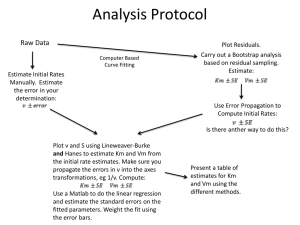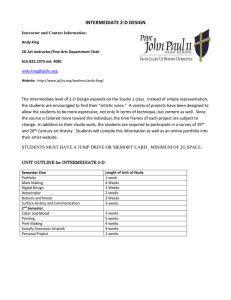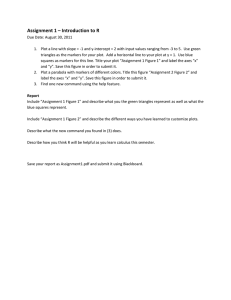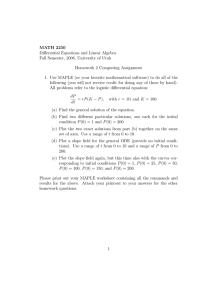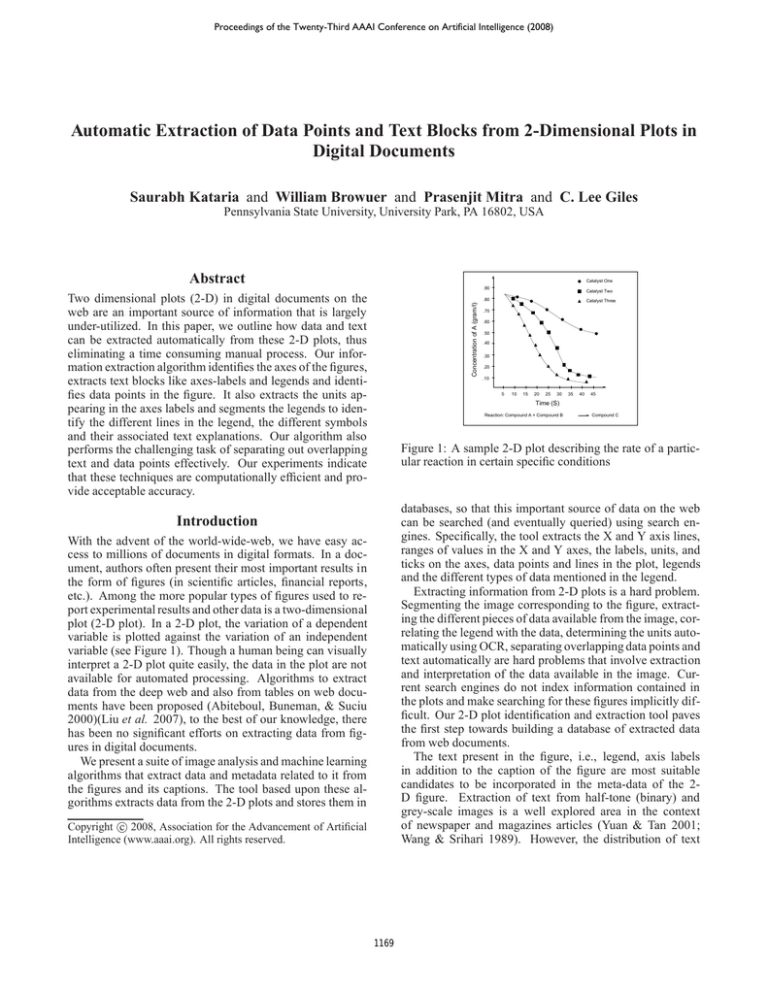
Proceedings of the Twenty-Third AAAI Conference on Artificial Intelligence (2008)
Automatic Extraction of Data Points and Text Blocks from 2-Dimensional Plots in
Digital Documents
Saurabh Kataria and William Browuer and Prasenjit Mitra and C. Lee Giles
Pennsylvania State University, University Park, PA 16802, USA
Abstract
Catalyst One
.90
Two dimensional plots (2-D) in digital documents on the
web are an important source of information that is largely
under-utilized. In this paper, we outline how data and text
can be extracted automatically from these 2-D plots, thus
eliminating a time consuming manual process. Our information extraction algorithm identifies the axes of the figures,
extracts text blocks like axes-labels and legends and identifies data points in the figure. It also extracts the units appearing in the axes labels and segments the legends to identify the different lines in the legend, the different symbols
and their associated text explanations. Our algorithm also
performs the challenging task of separating out overlapping
text and data points effectively. Our experiments indicate
that these techniques are computationally efficient and provide acceptable accuracy.
Catalyst Two
Concentration of A (gram/l)
.80
Catalyst Three
.70
.60
.50
.40
.30
.20
.10
5
10
15
20
25
30
35
40
45
Time (S)
Reaction: Compound A + Compound B
Compound C
Figure 1: A sample 2-D plot describing the rate of a particular reaction in certain specific conditions
databases, so that this important source of data on the web
can be searched (and eventually queried) using search engines. Specifically, the tool extracts the X and Y axis lines,
ranges of values in the X and Y axes, the labels, units, and
ticks on the axes, data points and lines in the plot, legends
and the different types of data mentioned in the legend.
Extracting information from 2-D plots is a hard problem.
Segmenting the image corresponding to the figure, extracting the different pieces of data available from the image, correlating the legend with the data, determining the units automatically using OCR, separating overlapping data points and
text automatically are hard problems that involve extraction
and interpretation of the data available in the image. Current search engines do not index information contained in
the plots and make searching for these figures implicitly difficult. Our 2-D plot identification and extraction tool paves
the first step towards building a database of extracted data
from web documents.
The text present in the figure, i.e., legend, axis labels
in addition to the caption of the figure are most suitable
candidates to be incorporated in the meta-data of the 2D figure. Extraction of text from half-tone (binary) and
grey-scale images is a well explored area in the context
of newspaper and magazines articles (Yuan & Tan 2001;
Wang & Srihari 1989). However, the distribution of text
Introduction
With the advent of the world-wide-web, we have easy access to millions of documents in digital formats. In a document, authors often present their most important results in
the form of figures (in scientific articles, financial reports,
etc.). Among the more popular types of figures used to report experimental results and other data is a two-dimensional
plot (2-D plot). In a 2-D plot, the variation of a dependent
variable is plotted against the variation of an independent
variable (see Figure 1). Though a human being can visually
interpret a 2-D plot quite easily, the data in the plot are not
available for automated processing. Algorithms to extract
data from the deep web and also from tables on web documents have been proposed (Abiteboul, Buneman, & Suciu
2000)(Liu et al. 2007), to the best of our knowledge, there
has been no significant efforts on extracting data from figures in digital documents.
We present a suite of image analysis and machine learning
algorithms that extract data and metadata related to it from
the figures and its captions. The tool based upon these algorithms extracts data from the 2-D plots and stores them in
c 2008, Association for the Advancement of Artificial
Copyright Intelligence (www.aaai.org). All rights reserved.
1169
in 2-D figures is not as dense compared to magazines and
newspapers and also, it is very likely that the position of
the data points and the text in the 2-D figure is hard to predict beforehand which implies that the distribution of the
data points in the 2-D figure presents a significant disturbance when trying to extract text from figures and viceversa. Therefore, a probabilistic treatment of connected
components is presented to separate the strings of text from
the data points.
Binarization
Axis/Region
Detection
X/Y Region
Axis Labels
OCR
OCR
Meta Data
Generation
Data Points
Detection
Data Points
Disambiguation
Meta Data
Data Set
Generation
Data Cordinates
Our work is a first step towards making the data in figures
from web documents available for querying and we recognize that there exist several other steps towards making this
data fully available to end-users. However, we believe that
drawing attention to the problem and providing the first set
of tools to perform the challenging task of data extraction
from figures in web documents is a significant contribution
in itself.
Data Region
Legend
Detection
Label
Detection
Legend
Tick Frequencies
Tick Frequency
Detection
Data Set
Figure 2: Process of Information Extraction from a 2-D plot
Problem Formulation
we define the problem and notations here that we use in the
rest of this paper. A 2-D figure contains three regions 1)
X-axis region containing X-axis labels and numerical units,
i.e., area below the horizontal axis in Fig 1., 2) Y-axis containing labels and numerical units, i.e., the area to the left of
vertical axis in Fig 1. and, 3) Curve region that contains legend text, and data points in case of curve-fitted plots or the
curve itself, otherwise. A 2-D figure depicts a functional distribution of the form yi = fi (xj ) with condition wi where
labels at the Y-axis and X-axis holds the text for y and x and
legend text provides the particulars for conditions w. The
values for these functions are represented by the data points
or the curve in the plot. We use the term plot metadata to refer to these textual values that provide the semantic meaning
to the data in the plot. In addition to the plot metadata, the
figure metadata consists of the figure caption and the document level metadata for the figure.
Identification of a 2-D plot in digital document is a hard
problem and is a pre-requisite to the information extraction problem. The identification problem is discussed in
(Browuer et al. 2008). In this paper, we address two specific
problems; 1) Metadata Extraction from the 2-D plot and its
indexing, and 2) Data Extraction from the 2-D plot.
Related Work
Content based image search and retrieval of image objects
has been extensively studied (Datta, Li, & Wang 2005)
(Doermann 1998). Using image understanding techniques,
features are extracted from image objects such as texture
features or color features and a domain specific indexing
scheme is applied to provide efficient search for related image objects. For instance, (Manjunath & Ma 1996) utilize texture features to index arbitrary textured images, and
(Smith & Chang 1996) utilize the spatial layout of regions to
index medical images and maps. We believe the text present
in different labels (i.e. legend, axis labels, caption) are most
descriptive of the figure in general. Previous work in locating text in images consists of different application-based
approaches such as page segmentation (Jain & Yu 1998),
address block location (Jain & Bhattacharjee 1992), form
(Yu & Jain 1996), and, color image-processing (Fletcher &
Kasturi 1988a). Text can be located in an image using two
primary methods (Jain & Yu 1998). The first treats text as
textured region into the image and applies well-known texture filters such as Gabor filtering (Manjunath & Ma 1996),
Gaussian filtering (Wu, Manmatha, & Riseman 1997), spatial variance (Zhong, Karu, & Jain 1995), etc. The second method uses connected components analysis (Yu &
Jain 1996), (Jain & Bhattacharjee 1992), (Jain & Yu 1998),
(Tang, Lee, & Suen 1996) on localized text regions and is
applicable to binary images, i.e. images having two pixel intensity levels. Generally, both methods are used in conjunction to first isolate the suspected text regions using texture
analysis and then using the binarized connected component
analysis. These methods are highly application-sensitive
and image structure drawn from domain knowledge is generally applied. Since most 2-D plots are best characterized
by binary images, therefore we use connected component
analysis for information extraction purposes.
Information Extraction from 2-D Plots
Here we show how to automatically generate the metadata
for the plot using the text that appears in the figure, and create a data set by identifying the data points. The metadata of
a 2-D plot should capture parameters such as the dependent
variable, the independent variable, conditions, etc.
The process flow of the information extraction is shown
in the figure 2 and is explained below.
Plot Segmentation
Plot segmentation is the process of identifying and separating all the three regions, defined earlier, of a plot. Specifically, the algorithm must find the position of the coordinate axes in the plot. The coordinate axes act as a global
1170
have been identified and, thus, the coordinate origin, by considering the profile in the regions immediately surrounding
x and y axes, the tick period or frequency can be determined.
These profiles have a pulse train shape, where peaks correspond to major ticks. To ameliorate the effects of noise, and
exploiting the simple relationship between a pulse train and
its Fourier transform, the transform of the pixel projections
are taken twice. The difference between successive peaks
thus provides the numerical spacing of the major axis ticks.
For tick frequency identification, we only consider the small
width around the coordinate axes(we used 5 pixels in both
directions) while calculating the axes profiles. The pseudocode for our algorithm is given below.
feature that identifies a 2-D plot. Profiling (or image signature) (Seul, O’Gorman, & Sammon 2000) is one important
technique to detect global features if a rough measure of the
image structure is known beforehand. This method is particularly suitable in our setting because almost all 2-D figures
will have two perpendicular lines, the axes of the figures.
The profile of a binarized image is calculated by counting
all the foreground pixels along a specified image axis. In
an image containing a single 2-D plot, the peak in the vertical profile corresponds to the Y-axis and the peak in the
horizontal profile corresponds to the X-axis. The horizontal
profile of the sample 2-D plot in fig. 1 is shown in the fig.
3(a). However, the profile based axis detection requires the
plot axes to be aligned with image axes, but in the presence
of the noise, e.g., in scanned images, the axes might not be
perfectly perpendicular or aligned to the image axes, which
may cause the proposed profiling technique to fail. Therefore, we need to perform a preprocessing step that enhances
the global feature of the plot. This preprocessing step identifies the potential axes lines in the 2-D plot and reconstructs
them aligned with the image axes. To determine axes lines,
one needs to find the pair of set of maximum foreground pixels lying on straight line in the binarized image such that the
slopes of two straight lines are almost orthogonal. This can
easily be achieved by employing the Hough transformation
to the original image (Duda & Hart 1972).
Algorithm Axis Tick Frequency Identification
Input: Binarized image segment S with dimensions (δ ∗ σ)
Output: Axis Tick Period and Pattern
1. Calculate axis profile prof ileX[1 . . σ] = Sum(S, δ)
2. Perform FFT twice, pattern ← FFT(FFT (prof ileX))
3. invert sort; difference between index i and index j gives numerical period of axis
ticks [βi , βj , . . βk ] = inv(sort (pattern))
4. return pattern(βi . . βj )
Text Block Extraction
Extracting text blocks from figures is more challenging than
the extraction of text blocks from the raster image of a document, because in 2-D figures a) the distribution of text is
sparse, and b) data points and lines introduce noise especially for the legend detection scheme. Note that a legend is
usually a mixed block containing symbols representing different data types as well as text and has to be extracted as
a single block. Therefore, the usual profile-based text-block
detection techniques employed for extraction of text from
documents (Jain & Bhattacharjee 1992) (Jain & Yu 1998)
cannot be used. Because data and text both occur in the 2-D
figure, it can not be directly processed by a standard optical
character recognition (OCR) system. Considering these factors, we need to perform a connected component analysis to
identify individual letters as a preprocessing step to recognize the text blocks that can, then, be sent to a standard OCR
tool.
Usually, the text present in a 2-D figure does not contain any texture, i.e. significant intensity variation within the
body of the text. Therefore, the loss of information is almost
negligible if the image pixel intensities are converted into binary values. To perform component analysis, we apply the
connected-component labeling scheme (Fletcher & Kasturi
1988b) that labels all the different connected components in
the image. Text possesses certain spatial properties such as
horizontal alignment and a certain spacing between characters, which distinguish the characters of a text string from
other components in the image. These spatial characteristics of the text components can be utilized to perform the
component analysis that provide the probabilistic location
of the text in the 2-D plot. Specifically, we employ fuzzy
rules based upon the spatial alignment of the characters to
cluster the components into potential strings of text and then
Hough transformation converts a binarized image from
its x-y co-ordinate space to ρ-θ space (parametric space
for straight line) where ρ,θ are the solution to the equation
xcosθ + ysinθ = ρ. Thus, every point in ρ-θ corresponds to a
set of collinear points in the x-y space. Also, the peaks in ρθ space corresponds to large segments of lines in x-y space.
Since axis lines in a 2-D plot are one of the largest straight
lines, therefore, the corresponding peaks are the brightest
(or dominant) in ρ-θ space. Also, the brightest peaks closest
to 0 and π/2 on θ−axis will correspond to horizontal and
verticle axis, respectively. The value of ρ for these peaks in
ρ-θ space provides the perpendicular distance of the corresponding lines from origin in x-y space.
Furthermore, simple heuristics can be developed to
segment figures with multiple 2-D graphs as there will be
multiple global maximas in the profiles corresponding to the
graphs. In this particular setting, an image is segmented into
its constituent 2-D plots and each plot is further segmented
into the three specified regions indicated above, which are
separately analyzed in later stages.
Tick Detection Typically, tick marks on the axes denote
intervals of measurement and usually appear with certain periodicity. We refer to this periodicity as tick frequency. If we
can identify the coordinate location of the ticks on the axis,
the values of the data points detected can be converted into
their real values. The tick marks on the axes can be identified
by performing Fast Fourier transforms on the axes profiles.
Profile calculation has been described earlier. Once the axes
1171
employ OCR. The details are presented as follows.
Let I(j, k) denote the raster matrix of the 2-D figure. We
have observed that figures do not have text blocks that occupy very large areas in the figures. Therefore, after the
connected component labeling, components that have an
area above a certain threshold are not considered as candidates for being extracted as text blocks. The result of performing the connected component labeling is a numbered
set of pixel matrices corresponding to each component, i.e.
CCL(I(j, k)) = {Ci }N
i=1 , where the area of the components are below the threshold.
After obtaining the connected components representing
single letters, we need to determine which letters are adjacent and part of the same text block and combine the components to create the block. We could determine some thresholds by which we would determine if two letters are adjacent. However, defining a fixed threshold would not lead to
good accuracy because different figures use different fonts
and spacing. Therefore, we want to use the distribution of
the spacing and the vertical distance of the connected components to identify which letters are adjacent and which are
parts of separate blocks. Let Xih , Xil , Yih , Yil represent the
corresponding maximum and minimum x and y coordinates
of the ith component, which indicate the height and width of
y
a component. Let Cij
denote the vertical distance between
y
x
any two components Ci and Cj i.e. Cij
= Yil − Yjl ; and Cij
denote the horizontal distance or spacing between Ci and
x
Cj i.e. Cij
= Xil − Xjh . The spatial alignment of the text
characters can be encoded using the following fuzzy rule.
y
x
If Cij
≈ a And Cij
≈ b , T hen Ci ← Ci ∪ Cj
Algorithm Text Detection in a 2-D Plot
Input: Binarized Image matrix Segmented with Regions
Output: Strings set for OCR input.
1. Initialize: strings-set ←φ; cc-set ←φ; δ ←20% of the image area
2. For X/Y Region
3. cc-set ←Connected Component Labeling
4. Detect the horizontal position of the text using horizontal profile for X region and
Verticle profile for Y region.
5. separate the text strings using Verticle Profile of the text identified in previous
step.
6. Approximate the parameters of Eq.2
7. For Curve Region
8. cc-set ←Connected Component Labeling
9. for each component Ci
10.
do if Area(Ci ) > δ
11.
then cc-set ←cc-set - Ci
12. for each pair of components Ci &Cj
13.
do Calculate P (Rij ) using Eq(2).
14.
if P (Rij ) > 0.05
15.
then string-set ←Ci , Cj
16.
strings-set ←string-set
17. return strings-set
Data Points Detection
Scatter and curve-fitted plots contain geometrical shapes that
serve as data points in 2-D plots. Our next step after text
block detection is to locate these data points. Isolation of
these data points from the curves is essential to perform the
shape detection in order to have a mapping with the legend. A reasonable heuristic that the curves have similar pixel
width to the width of axes can be utilized to filter the lines in
the curve region. We extend the basic idea of the k-median
filtering algorithm (Seul, O’Gorman, & Sammon 2000) to
perform this operation. To summarize the K-median algorithm, it is a first order pixel-noise filtering technique that
removes isolated foreground pixels. A raster scan of the image is performed with a square window of (k ∗ k) size with
k = 2 ∗ w + 1 where w is set depending upon the noise in
the image, e.g. w is set to 1 for 1-pixel noise. With each
new position in the window, the intensity of the most central
pixel in the window is assigned with the median intensity
value of all the pixels that lie in that window.
The K-median filtering algorithm uses a 2-dimensional
window, which is not able to preserve the contours of 2dimensional shapes because pixels at edges of the shape are
surrounded by a majority of background pixels. However,
this problem can be overcome by taking a 1-dimensional filter and treating line width as the noise intensity. Therefore,
we choose two windows of size (1 ∗ k) and (k ∗ 1) where
k = 2 ∗ w + 1 and then perform the raster scan of the image.
Using two 1-dimensional windows preserves even the pixels
at the edges of the two-dimensional data points reasonably
well, but removes narrow lines from the figure (as desired).
As pixel width and orientation of the data points has to be
different from the curve and the average pixel width of the
curve is almost similar to the axes width, therefore,w is set
to be at most the value of axis width. We calculate the pixel
width of the axes during the plot segmentation stage using
(1)
where a and b approximate the spatial alignment parameters.
y
The parameter a is the mean of the distribution of Cij
for all
pairs of i and j. The parameter b is defined similarly. By
applying the fuzzy rule, adjacent letters can be merged to
create a text block. In some cases, the text appears vertically
aligned, e.g., labels on the y-axis. For these characters, a
similar fuzzy rule can be defined by replacing x with y in
above equations. The fuzzy rule in Eq.1 can be encoded as
a bivariate Gaussian unit which is
P (Rij ) = e
−
y
(C −a)2
ij
2s2
1
·e
−
x −b)2
(Cij
2s2
2
(2)
, where s1 is the standard deviation corresponding to a and
denotes the allowed difference, i.e, vertical spread, and s2
is the standard deviation corresponding to b and denotes the
allowed difference in x-dimension. Rij is a random variable
that gives the probability of Ci and Cj belonging to the same
string or text block. However, the location of the strings of
text in X and Y region is easy to predict using the region
profile, for example, see the horizontal profile of only the
X-axis region in Fig 3 b). This extra information is useful
to accommodate the differences of various font shapes and
can be used to approximate the values of parameters of Eq.2
on a per figure basis. Next, we show the algorithm for text
detection in a 2-D plot.
1172
(a) Sample 2-D plot
(b) Horizontal Profile of (a)
(c) Text Detection
(d) Data Points Detection
Figure 3: Information Extraction process on a sample 2-D Figure
the profile of the 2-D plot. Figure 3(d) shows the result of
the operation of two modified k-median filters. te Overlapping data points are common in 2-D plots and recognizing
all the data points is especially challenging in this case. We
employed unsupervised learning technique based upon simulated annealing to accurately determine the ground state
and position of a geometric pattern (analogous to identifying the ground state of any physical system) of overlapping
points. Interested readers should refer to (Browuer et al.
2008) for details of data point disambiguation algorithm.
X Labels
Y Labels
Legend Text
Total
504
504
504
# Correct
428
441
398
% Recall
84.9
87.5
79.0
Table 1: Experimental results of Text Block Detection Algorithm
algorithm observes the distribution of the vertical distance
and the spacing of the letter components into X and Y axis
and approximate mean and standard deviations. However,
in almost 10% of the our figures, the location of the labels
in X or Y region was hard to decide based upon the profiling scheme discussed earlier. This was because there were
no global minima in the profile of the X or Y region, i.e.,
there were text positioned in the region in such a way that
their profile overlapped. In such cases, the algorithm failed
to identify the location of the labels in X & Y region and a
pre-specified set of distribution parameters were assumed.
We show the match results for the sample of 504 2-D plots
in table 1. We consider the X or Y label or the legend text
block correctly identified if, on an average, at least 70 % of
the identified letters in the blocks are correctly extracted.
As we used the spatial alignment parameters for the text
Experiments
The data set for our experiments is randomly selected publications crawled from the web site of Royal Society of Chemistry(www.rsc.org) and randomly selected computer science
publications from CiteSeer, digital library for scientific publications. Using (Browuer et al. 2008) classification scheme
for detecting 2-D plots which has 88.25% recall, we collected 504 2-D plots.
Text Block Detection
Fig 3(c) shows the result of our text block detection algorithm on a sample 2-D plot shown in fig 3(a). We sampled 504 2-D figures for the text block detection. The algorithm segments each plot into three regions. Next, the
1173
Total
504
# Correct
463
% Recall
92
segmenting overlapping data points can be addressed. Experimental results show that the data and text extraction from
the 2-D plots are fairly accurate. Future directions would include automatically extracting information from other graph
figures.
Table 2: Experimental results of Data Extraction Algorithm
block detection, some data points were incorrectly labeled
as text also. Particularly, in 20 figures, that had very dense
data point distribution, data points were incorrectly labeled
as text blocks. However, data points can be filtered out,
while we perform the OCR on the labeled text blocks.
There are many factors that affect the correctness of the
text block detection algorithm. Presence of noise, data point
interferences with the spatial alignment of the letters, different vertical alignment for certain letters e.g. ’y’,’j’ etc.
are some of the prevalent factors. Although, we noticed
a slight improvement in the accuracy measures with relaxation of the distribution parameter, however that improvement proved to be a trade-off in terms of labeling data points
as text blocks. The complexity of the text block detection algorithm is O(n), where n is the size of the image in pixels,
on a single processor and O(n ∗ (1 + logp)/p), where p is
the number of processors, on multiple processors. In case of
multiple processors, the extra overhead of (1 + logp) is due
to the recursive solution for connected component labelling
using divide and conquer strategy(Chaudhary & Aggarwal
1991).
Acknowledgments
This work supported in part by the National Science Foundation.
References
Abiteboul, S.; Buneman, P.; and Suciu, D. 2000. Data on the Web: from relations
to semistructured data and XML. San Francisco, CA, USA: Morgan Kaufmann
Publishers Inc.
Browuer, W.; Kataria, S.; Das, S.; Mitra, P.; and Giles, C. L. 2008. Segregation and
extraction of overlapping data points in digital documents. In JCDL ’08: Proceedings of the 8th ACM/IEEE-CS joint conference on Digital libraries. Pittsburgh, PA,
USA: ACM.
Chaudhary, V., and Aggarwal, J. K. 1991. On the complexity of parallel image
component labeling. In ICPP (3), 183–187.
Datta, R.; Li, J.; and Wang, J. Z. 2005. Content-based image retrieval: approaches
and trends of the new age. In Multimedia Information Retrieval, 253–262.
Doermann, D. S. 1998. The indexing and retrieval of document images: A survey.
Computer Vision and Image Understanding 70(3):287–298.
Duda, R. O., and Hart, P. E. 1972. Use of the hough transformation to detect lines
and curves in pictures. Commun. ACM 15(1):11–15.
Fletcher, L. A., and Kasturi, R. 1988a. A robust algorithm for text string separation from mixed text/graphics images. IEEE Trans. Pattern Anal. Mach. Intell.
10(6):910–918.
Data Extraction
Fletcher, L. A., and Kasturi, R. 1988b. A robust algorithm for text string separation from mixed text/graphics images. IEEE Trans. Pattern Anal. Mach. Intell.
10(6):910–918.
After filtering out the text blocks using the text block detection algorithm, we performed our data extraction algorithm
on rest of the 2-D figure. Fig subfig:4 shows the result of
the both text detection and data point detection algorithm.
We used the 504 2-D figures which had scattered or curvefitted plot in it. We call a figure an accept if more than 90
% of the data points gets correctly extracted with their shape
preserved. Table 2 shows the recall for the data extraction
algorithm. The complexity of the data point detection algorithm is O(n), where n is the size of the image in pixels,
on a single processor and O(n/p), where p is the number of
processors, on multiple processors.
Jain, A. K., and Bhattacharjee, S. K. 1992. Address block location on envelopes
using gabor filters. Pattern Recognition 25(12):1459–1477.
Jain, A. K., and Yu, B. 1998. Document representation and its application to page
decomposition. IEEE Trans. Pattern Anal. Mach. Intell. 20(3):294–308.
Liu, Y.; Bai, K.; Mitra, P.; and Giles, C. L. 2007. Tablerank: A ranking algorithm
for table search and retrieval. In AAAI-2007, 317–322.
Manjunath, B. S., and Ma, W.-Y. 1996. Texture features for browsing and retrieval
of image data. IEEE Trans. Pattern Anal. Mach. Intell. 18(8):837–842.
Seul, M.; O’Gorman, L.; and Sammon, M. J. 2000. Practical algorithms for image analysis: description, examples, and code. New York, NY, USA: Cambridge
University Press.
Smith, J. R., and Chang, S.-F. 1996. Visualseek: A fully automated content-based
image query system. In ACM Multimedia, 87–98.
Conclusion
Tang, Y.; Lee, S.; and Suen, C. 1996. Automatic document processing - a survey. In
Pattern Recognition, volume 29-12, 1931–1952.
We developed automated methods for extracting data and
text from two-dimensional plots from digital documents and
apply it to documents published on the web. This method
eliminates the time consuming manual process of retrieving
this data. The algorithm extracts axes, the ticks on the axes,
and the text labels associated with the ticks as well as the labels of the axes. It identifies the legend as a text-dominated
box in the figure and extracts the lines from the legend and
segments the lines to extract each data point symbol and
its textual description from the legend. Most importantly,
our tool extracts data points from the plots, identifies their
shapes and records the values of the X and Y coordinates
for that point. We outline how the challenging problem of
Wang, D., and Srihari, S. N. 1989. Classification of newspaper image blocks using
texture analysis. Computer Vision, Graphics, and Image Processing 47(3):327–352.
Wu, V.; Manmatha, R.; and Riseman, E. M. 1997. Finding text in images. In ACM
DL, 3–12.
Yu, B., and Jain, A. K. 1996. A generic system for form dropout. IEEE Trans.
Pattern Anal. Mach. Intell. 18(11):1127–1134.
Yuan, Q., and Tan, C. 2001. Text extraction from gray scale document images
using edge information. In Sixth International Conference on Document Analysis
and Recognition, 302–306.
Zhong, Y.; Karu, K.; and Jain, A. K. 1995. Locating text in complex color images.
In ICDAR, 146–149.
1174


